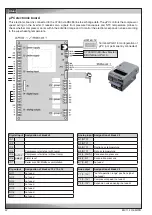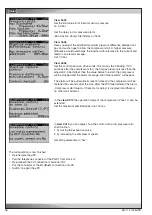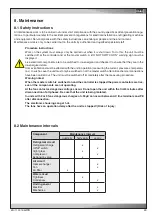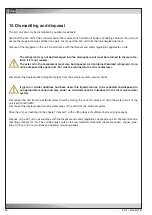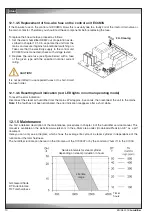
/11.2015/
G17D
51
EN
Compressor
In the compressor there is an ester oil charge, which does not have to be renewed under normal operation conditions
and holds out for the unit's lifetime. However, it is possible that the ester oil, as it reacts hygroscopically, has taken
up humidity of the air after repeated recharging of the refrigerant circuit due to repair works. The interaction between
ester oil and water results in the formation of acid. Owing to a hyperacidity, corrosive processes take place inside
the compressor. In this case the ester oil should be exchanged.
The oil level can be checked by looking at the sight glass of the compressor.
Units with a speed controlled compressor are not eqipped with an oil sight glass. For these A/C
units it is not allowed to recharge oil in case of refilling a refrigeration circuit after a leakage. In
such cases the compressor has to be exchanged.
Expansion valve
The refrigerant circuit is equipped with a electronic expansion valve, which controls the superheating in the evapo-
rator.The superheating is adjusted to 7 K at the factory and may not be modified. The expansion valve can freeze, if
the humidity in the system is excessive.
Do not thaw by soldering flame, danger of explosion ! Thaw with moist warm cloth. Check the sight
glass.
8.4 Air circuit
Heat exchanger (Evaporator / GE-coil)
The heat exchanger consists of copper tubes with aluminium fins. If refrigerant leaks occur, they should be searched
for at the heat exchanger. Beyond that, the heat exchanger is exposed to the air pollution, the particles of which
settle at the fins and reduce the heat transmission the same as raise the air resistance. The latter shows when the
fan current increases.
The heat exchanger can be cleaned by pressurized air which has to be blown opposite to the normal air flow direction
along the fins.
Do not distort the fins while cleaning, this also increases the air resistance !
Fan
The bearings of the fans are lifetime lubricated and do not need maintenance. Check the operation current. An in-
creased operation current indicates either a higher air resistance by a clogged pre-filter or a winding short circuit in
the fan motor.
The fans are speed controlled in dependance of the required cooling capacity. You can manually modify the speed
at the controller for test purposes, so as to compare the measured current with the values on the pages with the
technical data or with those of the planning tool.
Air filter
A filter monitor controls the state of the filter. As soon as the pressure loss exceeds an adjustable value, a filter alarm
via the controller is released. The controller can be configured such as to compensate the pressure loss by a higher
fan speed, however you should not wait too long for exchanging the filter. The filters can be accessed by the front
doors, depending on the cabinet size the number of filter elements varies.
The clogged filter elements can not be cleaned with pressurized air, as the filter structure would be destroyed other-
wise. When you re-install the filter elements after the exchange, take care that the side with the coloured mark (dirt
side) is turned away from the heat exchanger.






